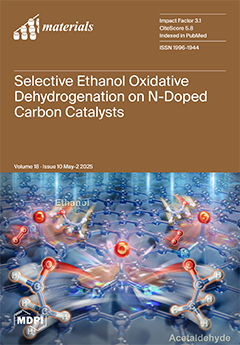The development of highly effective natural-based adsorbents to face the increasing rates of CO
2 production and their delivery to the atmosphere are a big concern nowadays. For such purposes, synthetic and natural zeolites were modified via an ion exchange procedure to enhance
[...] Read more.
The development of highly effective natural-based adsorbents to face the increasing rates of CO
2 production and their delivery to the atmosphere are a big concern nowadays. For such purposes, synthetic and natural zeolites were modified via an ion exchange procedure to enhance the CO
2 uptake. Samples were characterized by SEM, EDS, TGA and nitrogen adsorption at 77 K, showing the correct incorporation of the new metals; in addition, the CO
2 adsorption isotherms were determined using a gas analyser. During the first stage, the role of the compensation cations for CO
2 adsorption was assessed by modifying a pure ZSM-5 synthetic zeolite with different metal precursors present in salt solutions via an ion exchange procedure. Then, five samples were studied; the samples modified with bivalent cation precursors (Zn
2+ and Cu
2+) presented a higher adsorption uptake than those modified with a monovalent cation (Na
+ and K
+). Specifically, the substitution of the compensation cations for Cu
2+ increased the CO
2 capture uptake without affecting the surface properties of the zeolite. The results depict the prevalence of π-cation interactions enhanced by the field gradient induced by divalent cations and their lower ionic radii, if compared to monovalent ones. Subsequently, a natural zeolite was modified considering the best results of the previous phase. This Surface Response Methodology was implemented considering 11 samples by varying the concentration of the copper precursor and the time of the ion exchange procedure. A quantitative quadratic model to predict the adsorption uptake with an R
2 of 0.92 was obtained. The results depicted the optimal conditions to modify the used natural zeolite for CO
2 capture. The modification procedure implemented increased the CO
2 adsorption capacity of the natural zeolite more than 20%, reaching an adsorption capacity of 75.8 mg CO
2/g zeolite.
Full article






